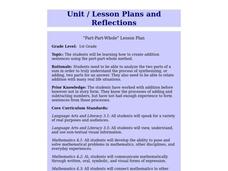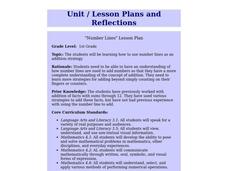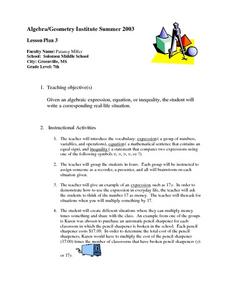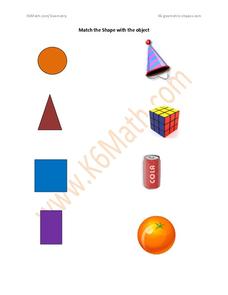Curated OER
Slosh, Dribble, and Plop
Students recognize the need for a standard unit of volume. They estimate and measure to the nearest liter. Also they relate the liter to the familiar everyday containers.
Curated OER
Planning A Household Budget
Students experience real life by utilizing math skills to plan a household budget and enhance their financial planning skills.
Curated OER
Giggle, Giggle, Quack Pizza Fractions
Students explore the concept of multiplication by using pizza. They read an article discussing how math is used everyday. They try to determine how many pizzas they would need to feed the class.
Curated OER
Whole Language Approach in Solving Word Problems
Students explore the concept of word problems. In this word problems lesson, students read a version of the Three Little Pigs. Students discuss what math vocabulary words such as 'in all' and 'many more' meant in the story.
Curated OER
My Test Book: Reading Pie Charts
In this math skills worksheet, students solve 9 multiple choice math problems that require them to read and interpret charts. Students may view the correct answers.
Curated OER
Part-Part-Whole
First graders work with partners, using cubes to make addition sentences. In this math lesson, 1st graders separate cubes into 2 parts and discuss the relationship to addition sentences. Students practice separating cubes. Students make...
Curated OER
Exploring Pascal's Triangle and Other Recursive Patterns
Students explore patterns in everyday life and in the mathematic world. They create various concrete examples of patterns and verbally describe these patterns to a fellow student.
Curated OER
Converting Units and the SR-71
Students practice solving problems logically. Using the internet, students observe pictures and facts about the SR-71 Blackbird. They convert statistics about the aircraft. Students explore terms of flight and convert them to everyday...
Curated OER
Number Lines
First graders examine the number line as an addition strategy. In this math lesson, 1st graders create a number line and use it to help them solve addition problems.
Curated OER
Representing and Extending Patterns
Young scholars explore repeating and growing patterns. In this patterns lesson, students describe patterns, explore changing patterns and match patterns. Young scholars participate in online activities and read books that show...
Curated OER
Graphing Trash Material
Students investigate data and recyclable materials. In this math lesson, students save recyclable materials and create a graph of the materials. Students discuss how they could help the environment by recycling.
Curated OER
Look for Patterns: Quilts in Two Faith Ringgold Stories
Author Faith Ringgold uses quilts to illustrate her books Tar Beach and Aunt Harriet's Underground Railroad. In this integrated trio of activities, young scholars read stories, identify and create patterns, and design quilt squares of...
Curated OER
Introducing the Concept: Rates
Sixth graders explore rates as a specific type of ratio, using visual examples of unit rates and unit prices to increase comprehension. They also practice solving problems that are modeled by the instructor. The well-scripted...
Curated OER
Real Life Situations
Pupils investigate different equations and think critically how they could represent a real-life situation. They should write a word problem to coincide with the given equations. The lesson plan requires students to use critical thinking...
Curated OER
Writing in Math Class
Students brainstorm and discuss ways math is all around them, explain in writing how they solve math problems, describe mathematical ideas in writing, and create original story problems.
Curated OER
Guesstimate? NO Estimate!
Students discover the advantage of estimation over simple guessing using number relationships. They also discover how useful a mathematical tool estimation is in everyday life.
Curated OER
Pattern Makers
Students are introduced to the notion of a repeating pattern. This is done by a number of means including the use of everyday objects. They are encouraged to create, describe and continue patterns.
Curated OER
Geometric Solids
First graders identify various shapes in everyday objects. in pairs, 1st graders go on a shape field trip to locate various objects of different shapes. They photograph the objects and later use the prints to write sentences describing...
Curated OER
Where in the World is Tacky the Penguin?
First graders complete activities related to they story they are reading in class. Through art and measurement activities, 1st graders relate a story from the "Tacky the Penguin Series" to everyday objects and ideas they encounter.
Curated OER
Match the Shape
In this visual discrimination activity, students match the circle, triangle, rectangle, and square to the appropriate everyday objects that have those shapes.
Curated OER
Match the Shape
In this geometry skills practice instructional activity, students respond to 4 questions that require them to match everyday items as the geometric shapes they represent.
Curated OER
Invent a .....
Learners explore inventions. For this physical science invention lesson, students work with a team to create an invention using everyday materials.
Curated OER
Money Math
Young scholars investigate the characteristics of the different coins. The teacher presents each coin, and the students identify the distinguishing characteristics of each side of the coin, and the value of each coin. The young...
Curated OER
Parallel and Perpendicular Lines and Lines of Symmetry: Rhombus Shadowing
Fifth graders demonstrate different types of lines using movement. In this line and movement lesson plan, 5th graders demonstrate parallel and perpendicular lines, and lines of symmetry using dance movement. They also demonstrate rhombus...
Other popular searches
- Everyday Mathematics
- Math in Everyday Life
- Everyday Math Skills
- Everyday Math Grade 5
- Everyday Math Number Sense
- Everyday Math Fourth Grade
- Everyday Math Grade 2
- Grade 1 Everyday Math
- Everyday Mathematics Arrays
- Algorithms in Everyday Math
- Everyday Math 3
- Everyday Mathematics Review























